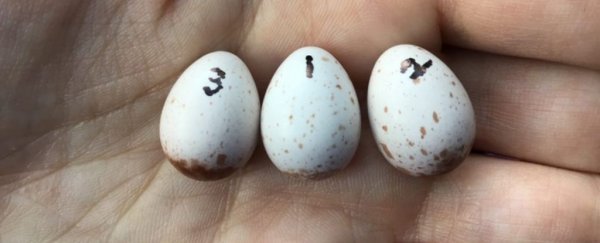Songbirds usually need very little instruction to belt out the tunes of their kin, but the right melody doesn't necessarily come to them 'out of the blue' the moment they hatch.
Instead, a new study suggests most baby birds start listening and responding to surrounding birdsong as mere embryos, while still tucked inside their eggs.
Even when a species is considered an 'innate' singer – one with the correct genetics and brain wiring to produce the song of its species once hatched – researchers found some evidence of embryonic learning as well.
With enough time and repetition, it seems unhatched baby birds commonly become accustomed to noises from outside their shell, and this forms an important part of their vocal development.
"Long before actual vocalization, we found that these tiny songbirds were also discriminating towards non-specific sounds and capable of 'non-associative' (not from parents) sounds, building on the complexity of vocal learning in songbirds," says animal behaviorist Diane Colombelli-Négrel from Flinders University in Australia.
According to historic classification, birds (and other animals) are either vocal learners, capable of coming up with new songs or imitating those of others; or non-learners, stuck with their 'innate' repertoires that arise from brain wiring and genetics.
In recent years, however, researchers have started to argue that this binary system of vocal learning in vertebrates is too simplistic, and we're actually dealing with more of a spectrum or continuum.
At one end of the range is a high degree of vocal learning, with species able to imitate all kinds of novel sounds – many songbird lineages fall into this category, as do humans. At the other, you get the relatively limited non-learners, who can only produce the sounds of their own species, and nothing else.
The rest of the avians fall somewhere along the continuum of learned and non-learned vocalizations and sometimes, it's hard to distinguish between the two.
Even among 'acoustically naive' songbirds, who have received little, if any, vocal tutoring, studies have shown the sounds of their own species elicit a stronger neural response than a song from a foreign species.
This suggests baby birds acquire a 'vocal template' in their brains well before they hatch, and the new research on bird embryos now supports that idea.
Over the course of seven years, between 2012 and 2019, researchers played a variety of bird calls to the eggs of five different bird species.
These included the superb fairy-wren (Malurus cyaneus), the red-winged fairy-wren (Malurus elegans), Darwin's small ground finch (Geospiza fuliginosa), the little penguin (Eudyptula minor), and the Japanese quail (Coturnix japonica domestica).
The wrens and Darwin's finch are considered vocal learners, while the quail and penguin are typically classified as non-learners. During the first part of the experiment, researchers exposed 109 embryos to 60 seconds of noise, bookended by 60 seconds of silence.
Compared to the embryos of non-learners, like penguins and quails, the authors found the embryos of vocal learners showed a more fine-tuned response to the call of their own species at a much earlier stage of development.
This was expected, as recent studies have shown vocal learners, like zebra finches, can have their behavior in adulthood altered by the songs their parents sing to them as embryos. Non-learners, on the other hand, don't appear to have such malleable brains. But that doesn't mean they don't absorb any songs while in the egg.
In the second part of the experiment, researchers exposed 138 embryos to 180 seconds of the same bird song, either from their own species or another, bookended once again by a minute of silence.
This time, the heart rate of each embryo was measured to determine how much attention the baby bird was paying to the repeated call.
Ultimately, the authors found all the birds, learners and non-learners alike, grew accustomed to the repeated external sound, regardless of whether it came from their own species or a different species.
This indicates a level of innate learning known as habituation, which might help the animals distinguish between friendly calls and the calls of another.
"The findings of this study suggest that the capacity to perceive and habituate to sound in ovo in developing birds may be more widespread taxonomically than previously considered and also support the idea that vocal perception learning is not a binary behavior," the authors write.
It's still unclear if that initial embryonic learning changes the behavior of birds once they are hatched, but the authors suspect the sound could start preparing embryos for life outside the egg, albeit in slightly different ways with slightly different timing depending on the species.
For example, studies have already shown the unhatched embryos of some gulls can hear warning calls from their parents. What's more, when these same birds are born, they tend to show more defensive behaviors, higher stress levels, and are especially attuned to alarm signals.
Further research will be needed to compare how the sounds that drift through the shell of an egg impact vocal learners and non-learners as they grow up.
"This research will hopefully inspire more study into the remarkable capacity of animals to learn sound," says systems biologist Sonia Kleindorfer from Flinders University and the University of Vienna.
"By moving the time window for sound learning to the prenatal stage, this research direction opens pathways to measure neurobiological downstream effects of early auditory experience on behavior and information processing."
The study was published in Philosophical Transactions of the Royal Society B Biological Sciences.
